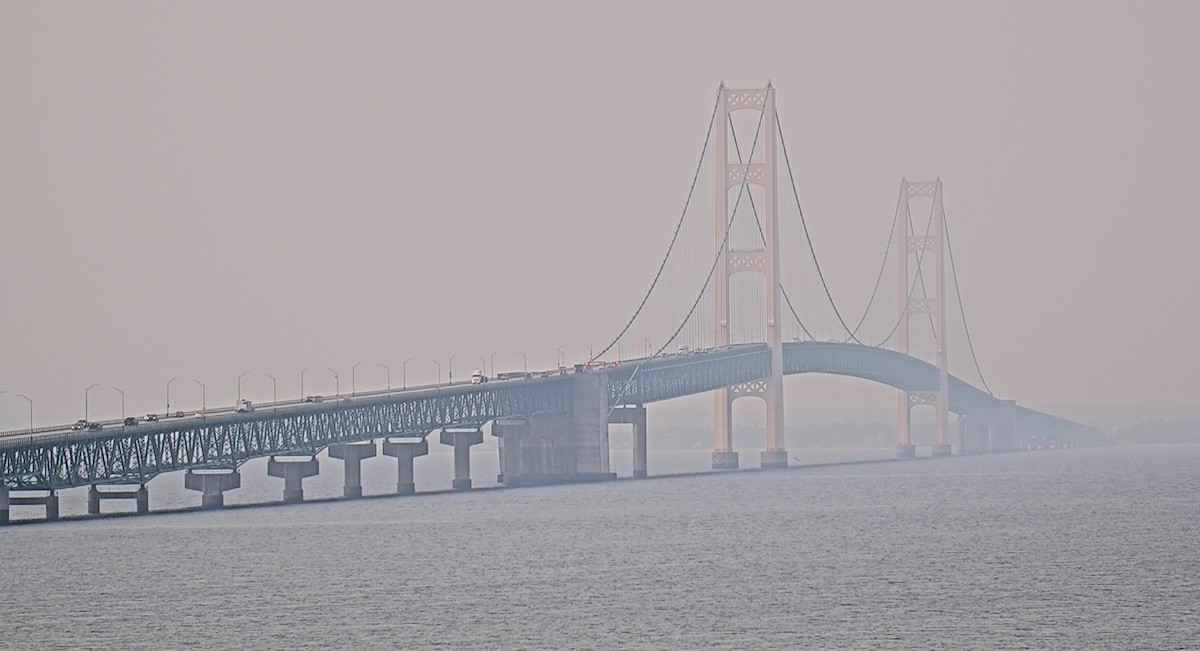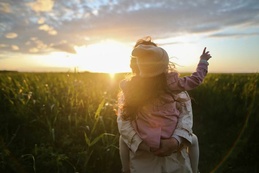
The Science Behind Smoky Summer Skies and Fall Fire Risks
Poor air quality, man-made fires, and what we can do about it
By Ren Brabenec | Oct. 18, 2025
The Great Lakes State is renowned for its pleasant summer weather, but when Michigan was shrouded in a cloud of choking smoke day after day this summer—including days where the might Mackinac Bridge seemed to disappear—a sense of anguish set the tone, as many residents could not even step out their front doors due to poor air quality. But we aren’t out of the woods yet, as autumn is peak season for man-made wildfire action.
State of the Air
The Michigan Department of Environment, Great Lakes, and Energy (EGLE) issued 27 air quality advisories and four air quality alerts from May through late August this year. Between July 30 and August 5, EGLE issued seven consecutive statewide advisories.
According to EGLE, the advisories and alerts were primarily caused by Canadian wildfire smoke reaching the upper and lower peninsulas (although other factors also contributed to poor air quality). For context, air quality advisories are issued when air pollution is unhealthy for sensitive groups, whereas air quality alerts are issued when the air becomes so polluted that it’s unhealthy for the entire population.
EGLE wasn’t the only one raising the alarm. The American Lung Association (ALA) reported that almost all Michigan counties that report air quality received failing grades on several days this year, due mostly to Canadian wildfire smoke. According to the ALA, Canada’s 2023, 2024, and 2025 wildfire seasons have been intensified by climate change, resulting in the nation’s worst fire seasons on record.
The Canadian blazes have been so extreme that their smoke has traveled across the continent, posing respiratory health risks thousands of miles away, which is part of why the ALA now reports that 46 percent of Americans are currently living in places with failing grades for air quality. That’s 25 million more than in last year’s report and more than in any other State of the Air report in the last 10 years.
Meteorology and Wildfires
“We have this principle called the ‘Wildfire Triangle,’” says Eleanor Dhuyvetter, a Gaylord-based National Weather Service meteorologist. “The three points to the triangle are topography, fuels, and weather. The shape of the land, what kind of flammable material [fuel] is present, and the weather patterns that day all play key roles in how a wildfire will develop, where it will travel to, how long it will burn for, etc.”
She emphasizes the importance of the weather factor. “Topography and fuel are basically fixed variables in any given fire, but the weather is not. Weather is critical during a wildfire, because changing weather can completely alter the course or intensity of a fire, putting residents, properties, infrastructure, and firefighters at increased risk.”
Dhuyvetter not only closely monitors weather patterns in northern Michigan and coordinates on wildfire weather forecasts with the National Park Service, National Forest Service, and other land management agencies, but she also serves as an incident meteorologist and deploys to complex wildfire systems throughout the country to support firefighter teams with essential weather data.
According to Dhuyvetter, northern Michigan has experienced an average year in terms of local wildfires, which is also true of the U.S. more broadly.
But that’s not the case in Canada, which Dhuyvetter says has been the primary source of wildfire smoke in Michigan this year.
“The year’s not over yet, so our reporting is still a work in progress, but Canada is at about 5,347 incidents year to date,” she says. “And that’s pretty normal, but what’s not normal is the sheer land coverage of these wildfires.”
Dhuyvetter quickly types some commands into her work computer, pulls up a map, and shows us in real time what she was referring to. “The wildfire-affected area in Canada is almost double the 10-year average,” she says. “As of right now, 8.7 million hectares have burned. That’s almost double what’s considered normal for Canada’s fire season, and the year isn’t over.”
Dhuyvetter reminds us that the same thing happened in 2023, Canada’s worst year in recorded history for wildfires, and another year of widespread fires that caused severe smoke conditions in Michigan.
The Science Behind the Smoke
How does smoke from these wildfires get all the way to the Great Lakes State, if the fires are occurring thousands of miles across the continent?
“It gets a bit science-y,” Dhuyvetter says with a chuckle. “You know that weather variable we touched on earlier, how local weather patterns influence a wildfire’s behavior in its immediate vicinity? Well, broader weather patterns are also the primary culprit in influencing wildfire smoke behavior on a continental level.”
Dhuyvetter explains it all comes down to cold fronts. When a cold front comes down through Canada and into Michigan, it stays close to the ground because hot air rises and cold air sinks. Cold fronts moving across Canada are incredibly common, and they often pick up wildfire smoke and push it ahead of them, much like a snowplow pushes snow.
“Cold fronts prevent wildfire smoke from rising higher into the atmosphere and essentially dissipating,” Dhuyvetter says. “These fronts are full of cold, dense air that stays low to the ground. The cold fronts move through Canada, pick up the wildfire smoke, keep the smoke close to the ground where humans live, and then push the smoke across the continent for sometimes thousands of miles before dissipating.”
Dhuyvetter emphasizes that the cold fronts don’t actually have to be that “cold” per se. They just have to be colder than the surrounding air. “It could be 80 degrees Fahrenheit on a warm July day here in northern Michigan, but if you feel that slight cool breeze coming out of the northwest, that’s probably a cold front from Canada, and if there was a wildfire anywhere between us and where that cold front originated, it’s probably going to be bringing some wildfire smoke with it.”
Protecting Your Home and Your Health
It’s never a bad time to think about wildfire preparedness, especially because fires can ramp back up in the fall thanks to all that fresh tinder from fallen leaves (and folks improperly burning them).
Dhuyvetter says the first thing residents should do is become aware of when wildfire risks are greatest. She says the spring and fall seasons are the highest risk periods for wildfires in the state of Michigan. The spring months pose a heightened risk because plant life (fuel for fires) is still dormant from winter and hasn’t “greened up” yet. The same occurs in autumn, only in reverse. Snow cover during winter and rain combined with green plants during summer work to reduce wildfire risk, although that risk is never fully eliminated.
The next piece of advice focuses on protecting the home.
“Protecting your home during wildfire season is all about creating defensible space,” Dhuyvetter said, pointing us to the U.S. Forest Service’s advice on the matter. “Defensible spaces are essentially spaces around your home that will not catch on fire,” she adds. “It’s about not growing trees too close to your house. It’s about removing shrubs and undergrowth near your home and keeping your grass short and well-watered during drought periods. The idea is to reduce the presence of natural fuels near your home so that, even if your property does suffer a wildfire, damage to your house will be, ideally, minimal.”
Next, it’s essential not to contribute to the problem. According to the Michigan DNR, the overwhelming majority of wildfires in the Great Lakes State are caused by humans. “The DNR puts out alerts on when it allows or does not allow for burning,” Dhuyvetter says. “Be aware of wildfire risk in your area at any given time and follow the rules around burn permits and bans.”
Last but not least, Dhuyvetter says it’s important to follow EGLE’s guidance on air quality alerts, especially because, even if every Michigander became an expert in fire prevention and were able to reduce Michigan wildfire incidents to zero or near zero, Michiganders would still have to contend with wildfire smoke coming in from out-of-state.
“If you’re in a sensitive group, don’t go outdoors during poor air quality days,” Dhuyvetter says. “Even if you’re not in a sensitive group, take the advisories and alerts seriously. You might not be able to feel the effects of that smoky air right away, but the smoke is having an effect on your health from that very first inhalation onward.”
This fall, keep an eye on local burn conditions at dnr.state.mi.us/burnpermits.
Photo Courtesy of the Mackinac Bridge Authority
Trending

Fighting Harder for Local Women and Children
Traverse Bay Children’s Advocacy Center (TBCAC) has been navigating a particularly challenging year. Though CEO Lande… Read More >>
Christmas in Sweden (by way of Benzie)
Musical duo Ingemar and Lisa Johansson, also members of Song of the Lakes group, bring “Christmas in Sweden: A Musical… Read More >>
Searching for a Sugar High
In the words of Cookie Monster, “NOM NOM NOM.” It’s cookie season, and we’re here for every gingerbr… Read More >>


